It looks like you're using an Ad Blocker.
Please white-list or disable AboveTopSecret.com in your ad-blocking tool.
Thank you.
Some features of ATS will be disabled while you continue to use an ad-blocker.
share:
I’ve been saving this one since the day I read it, about a year ago and decided to put it in quarantine to give it a chance to be debunked. The
evidence seems to be even more solid now so I think it’s time to share all this with you dear friends.
It might affect your point of view about some historical events and maybe confuse you even more. Disclose with me an untold side of this war between 3 religions: Christians, Jews and Muslims.
THE TOMB OF THE COQUISTADOR.
There is no doubt about the credibility of the information. Dr. Hugo Ludeña has published his research in the Academy of Forensic Sciences of the United States and in journals of anthropology and cultural osteology, with world-renowned experts and studies around the conqueror of Peru have been recognized since 1985 as a prototype for the specialized study of the archaeological remains of historical figures.
First, we have to go back in time to the 80’s, when Dr. Ludeña (Archaeologist / Anthropologist) and a team of experts uncovered a historical lie: the mummy was displayed in a glass crypt in the Cathedral Basilica of Lima (Peru) was not the conqueror Francisco Pizarro.
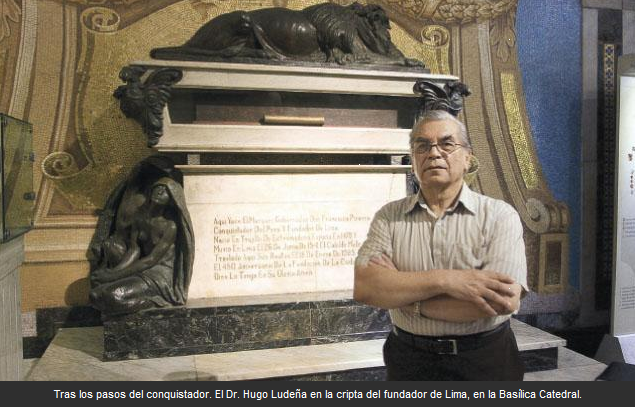
Francisco Pizarro was the Spanish conquistador who conquered the Incan Empire, so imagine how big was Dr. Ludeña’s team discovery.

The investigation continued and eventually they found another ossuary, with the skull and some bones of the founder of Lima. The tomb had inscriptions and this time they were able to confirm that the bones belonged to Pizarro. These bones were carefully analyzed and belonged to a man of little more than 60 years with mortal wounds signals matching the historical references to the murder of Pizarro.
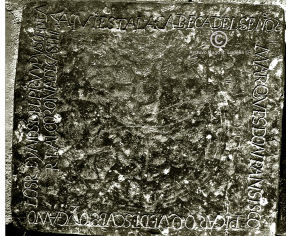
The metal and wood box was illustrated with the symbol of the Order of Santiago, which belonged Pizarro, and a rosette of six petals that caught the attention of Ludeña.

THE ORDER OF SANTIAGO.

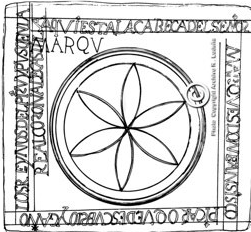
The same symbol is engraved in stone ossuaries many Jews preserved in the museums of Israel and some Jewish art collections in several foreign museums.
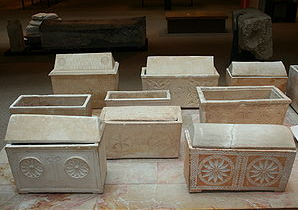
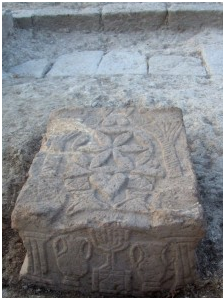
Now, let me dedicate a few lines to the “Orden de Santiago” (Order of Santago), really interesting. The order was founded to protect and help the pilgrims who came to Jerusalem. Its members were called Knights. See Pizarro with the symbol of the Order of Santiago :
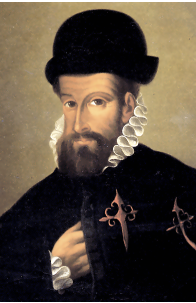
The Knights belonged to the nobility and their office was to protect pilgrims and fight the infidels. The order of Santiago was founded in 1170 by King Ferdinand II of León to defend against the Almohad Caceres and his mission was to defend the Muslim-border of Leon.
Today you can find them in facebook.
THE ROSETTE.
Years later, Ludeña tried to decipher the enigma of the rosette, During a recent research conducted at an ancient temple in Israel, archaeologists found several stone coffins adorned with this enigmatic floral symbol.
Raúl Porras Barrenechea (Peruvian historian 1897 – 1960), believed that Pizarro's mother, surnamed Gonzales, lived in a neighborhood of Sephardic Jews in Trujillo de Extremadura (Spain).
Ludeña also wrote an article with many detalis about jews in Spain, let me quote the first paragraphs here, but I strongly recommend to translate and read the whole aricle.
Now, the next segment of the thread is something we should pay attention, considering the sad events taking place in our days, maybe we should keep an eye on Spain this year. Read :
larepublica.pe...
www.larepublica.pe...
www.unfv.edu.pe...
www.ordensantiago.com...
www.foropolicia.es...
es.wikipedia.org...
esefarad.com...
www.euronews.com...
It might affect your point of view about some historical events and maybe confuse you even more. Disclose with me an untold side of this war between 3 religions: Christians, Jews and Muslims.
THE TOMB OF THE COQUISTADOR.
There is no doubt about the credibility of the information. Dr. Hugo Ludeña has published his research in the Academy of Forensic Sciences of the United States and in journals of anthropology and cultural osteology, with world-renowned experts and studies around the conqueror of Peru have been recognized since 1985 as a prototype for the specialized study of the archaeological remains of historical figures.
First, we have to go back in time to the 80’s, when Dr. Ludeña (Archaeologist / Anthropologist) and a team of experts uncovered a historical lie: the mummy was displayed in a glass crypt in the Cathedral Basilica of Lima (Peru) was not the conqueror Francisco Pizarro.

Francisco Pizarro was the Spanish conquistador who conquered the Incan Empire, so imagine how big was Dr. Ludeña’s team discovery.

The investigation continued and eventually they found another ossuary, with the skull and some bones of the founder of Lima. The tomb had inscriptions and this time they were able to confirm that the bones belonged to Pizarro. These bones were carefully analyzed and belonged to a man of little more than 60 years with mortal wounds signals matching the historical references to the murder of Pizarro.

The metal and wood box was illustrated with the symbol of the Order of Santiago, which belonged Pizarro, and a rosette of six petals that caught the attention of Ludeña.

THE ORDER OF SANTIAGO.


The same symbol is engraved in stone ossuaries many Jews preserved in the museums of Israel and some Jewish art collections in several foreign museums.

Also the symbol of the rosette of six petals was found engraved on the stones of the oldest synagogues in Israel and Masada, the fortified city that was destroyed by the Roman army in the war against the Jews between 66 and 70 DC while destroyed and looted the Temple of Jerusalem.
Finally, we know that during Biblical Archaeology investigations in Israel, the symbol was found in excavations of the ruins of a synagogue in Magdala, a biblical place near Lake Tiberias, which was the native village of Mary Magdalena, where he is currently an important and modern pilgrimage center is built to the Holy Land.

Now, let me dedicate a few lines to the “Orden de Santiago” (Order of Santago), really interesting. The order was founded to protect and help the pilgrims who came to Jerusalem. Its members were called Knights. See Pizarro with the symbol of the Order of Santiago :

The Knights belonged to the nobility and their office was to protect pilgrims and fight the infidels. The order of Santiago was founded in 1170 by King Ferdinand II of León to defend against the Almohad Caceres and his mission was to defend the Muslim-border of Leon.
Today you can find them in facebook.
THE ROSETTE.
Years later, Ludeña tried to decipher the enigma of the rosette, During a recent research conducted at an ancient temple in Israel, archaeologists found several stone coffins adorned with this enigmatic floral symbol.
Raúl Porras Barrenechea (Peruvian historian 1897 – 1960), believed that Pizarro's mother, surnamed Gonzales, lived in a neighborhood of Sephardic Jews in Trujillo de Extremadura (Spain).
Ludeña also wrote an article with many detalis about jews in Spain, let me quote the first paragraphs here, but I strongly recommend to translate and read the whole aricle.
Between the thirteenth and fifteenth centuries in Trujillo settlers there were three communities: Christians, Jews and Moors. Grandparents and parents of Francisco Pizarro lived among these communities, first under Arab domination and after the reconquest, under Christian rule. During the Arab rule, there were Christian converts and Jews. After the reconquest, he was Arab and Jewish converts to Christianity.
Converts retained their beliefs and who were returned to their original religions. The most steadfast in their religious convictions and the Jews were persecuted. The converts were called "Marranos" by Christians who regarded them as false believers, as Christians who concealed their Jewish identity to gain access to important positions or avoid confiscation of their property.
Indeed, some conversos returned to Judaism, but most would rather take an ambiguous life, full of secrets. They preferred life, renouncing and abjuring Levi, but always had the opportunity to return to their faith. Grandparents and parents of Francisco Pizarro lived in this full of ambiguities and hypocrisies world until in 1478 established the Inquisition in Spain was when religious persecution radicalized. Francisco Pizarro was born that same year.
Now, the next segment of the thread is something we should pay attention, considering the sad events taking place in our days, maybe we should keep an eye on Spain this year. Read :
In 1492 Spain’s Catholic monarchs passed a law, the Edict of Expulsion of the Jews, which forced Spanish Jews either to become Catholic or go into exile. The people who left Spain were called Sephardic Jews, from the Hebrew word Sepharad, meaning a place from which people are exiled.
Exiled Jews kept their house keys as a reminder of their lost homeland, and the diaspora spread from the Ottoman Empire to the New World.
Five hundred years later, Spain is considering a law which will grant Spanish citizenship to the descendants of those exiled. Sephardic Jews from all over the world could get double nationality, with all the associated benefits of having an EU passport.
Sephardic Jew Alejandra Abulafia said: “For me a Spanish passport represents the return to our lost homeland. It’s a key. I don’t think Sephardic people from all over the world will return to Spain. They will just apply for citizenship and then stay where they are. Most of them have no interest in moving to Spain. They kept the key as a nostalgic symbol. Now, they want to recover the door of their ancestors’ home, and Spain is that door.”
The new law has already been approved by Spain’s Council of Ministers and is expected to enter force early in 2015. It is estimated that between 90,000 and 500,000 Jews could apply for Spanish citizenship over the next five years, costing Spain around 30 million euros.
larepublica.pe...
www.larepublica.pe...
www.unfv.edu.pe...
www.ordensantiago.com...
www.foropolicia.es...
es.wikipedia.org...
esefarad.com...
www.euronews.com...
edit on 8-2-2015 by Trueman because: (no reason given)
So the leap of faith required here is this.
A simple six-petal flower design was on a box of bones that was apparently Francisco Pizarro, the Conquistador from Catholic Spain. The flower design is similar what anyone would doodle during a boring meeting at work.
This six-petal design is similar to those found on some boxes of bones held in Jewish museums. Being a symmetrical rosette design, it’s also (coincidently) found on a host of other heraldic symbols, in art and everywhere, but that’s an inconvenience because only the Jews used this design.
While there is context her that I understand i.e. the expulsion of Jews from Spain and there is the hypothetical chance that Pizarro was a “secret” Jew, this is highly speculative and not bound by any evidence, so no, the Incan Empire was not brought down by the Jews. Pizarro – and other Conquistadors – carried Papal authority.
Regards
A simple six-petal flower design was on a box of bones that was apparently Francisco Pizarro, the Conquistador from Catholic Spain. The flower design is similar what anyone would doodle during a boring meeting at work.
This six-petal design is similar to those found on some boxes of bones held in Jewish museums. Being a symmetrical rosette design, it’s also (coincidently) found on a host of other heraldic symbols, in art and everywhere, but that’s an inconvenience because only the Jews used this design.
While there is context her that I understand i.e. the expulsion of Jews from Spain and there is the hypothetical chance that Pizarro was a “secret” Jew, this is highly speculative and not bound by any evidence, so no, the Incan Empire was not brought down by the Jews. Pizarro – and other Conquistadors – carried Papal authority.
Regards
a reply to: paraphi
A simple six-petal flower design was on a box of bones that was apparently Francisco Pizarro, the Conquistador from Catholic Spain. The flower design is similar what anyone would doodle during a boring meeting at work.
You used the word "apparently" and "similar", which is wrong. Please read again. Do you have better credentials than Dr. Ludeña and his team, in order to doubt what they said?
I provided a great amount of links and references. I know it's hard to face it.
originally posted by: Boomy327
Very true the symbol is called "the seed of
Life" by new agers. It's a basic of "sacred geometry". This symbol pops up everywhere.
a reply to: paraphi
I think there were not "new agers" in those days. Provide information of the use of the same symbol by other groups that existed in the same time that Pizarro.
People seem to take such great pride in trying to debunk things. Can't you just accept something as an interesting possibility? Does it really affect
your grip on reality so much to think the history books could be wrong? Accidentally or deliberately doesn't matter.
edit on 8-2-2015 by
Eunuchorn because: (no reason given)
originally posted by: Eunuchorn
People seem to take such great pride in trying to debunk things. Can't you just accept something as an interesting possibility? Does it really affect your grip on reality so much to think the history books could be wrong? Accidentally or deliberately doesn't matter.
Great words, thanks.
Somehow I was prepared to some sort of reactions to what I exposed. That's why I wanted to wait a year before post it, to find out how solid the evidence becomes. There is not only one expert in the topic quoted in my initial post and all of them are highly renowned. Very, very little chances that they could be wrong. Painful truth.
originally posted by: Eunuchorn
People seem to take such great pride in trying to debunk things. Can't you just accept something as an interesting possibility? Does it really affect your grip on reality so much to think the history books could be wrong? Accidentally or deliberately doesn't matter.
Ok,
Look at the title: "Conquered by Jews"
Now if someone is trying to possibly question a link that either a person or order has some Jewish connection based on a symbol is one thing but the "Conquered by Jews" reflects an agenda or bias immediately which will get a negative response.
edit on 8-2-2015 by infolurker because: (no
reason given)
There could well be something in this. Many of the original settlers in the Spanish new world were secret Jews fleeing persecution in Spain. Like many
Christian people in New Mexico USA discovering that their descendants were infact Jews. Even in Spain many people are descended from Jews that
converted, can't remember the figure but something like 1 in 5. So there's a good chance Pizarro was one of the secret Jews.
originally posted by: infolurker
originally posted by: Eunuchorn
People seem to take such great pride in trying to debunk things. Can't you just accept something as an interesting possibility? Does it really affect your grip on reality so much to think the history books could be wrong? Accidentally or deliberately doesn't matter.
Ok,
Look at the title: "Conquered by Jews"
Now if someone is trying to possibly question a link that either a person or order has some Jewish connection based on a symbol is one thing but the "Conquered by Jews" reflects an agenda or bias immediately which will get a negative response.
Wrong and biased. The first word of the title is "MAYBE".
: possibly but not certainly
www.merriam-webster.com...
a reply to: Trueman
Santiago is derived from the Hebrew name Jacob, according to wikipedia
www.google.com.co...
Now, let me dedicate a few lines to the “Orden de Santiago” (Order of Santago), really interesting. The order was founded to protect and help the pilgrims who came to Jerusalem. Its members were called Knights
Santiago is derived from the Hebrew name Jacob, according to wikipedia
www.google.com.co...
There is also the strong chance that a rare severe freeze in the middle of summer could have frozen them.
If it is 80 degrees out and in a two hour period the temp drops to -20 then most will die.
The remains would likely be consumed after that and no trace would be found.
It has happened before.
If it is 80 degrees out and in a two hour period the temp drops to -20 then most will die.
The remains would likely be consumed after that and no trace would be found.
It has happened before.
a reply to: Trueman
Maybe the American Indians Were Conquered by Blacks
If that title were given to a post about finding African-esque relics in an Amerindian burial mound, would you not find it provacative?
Would you see where an illogical and biased assumption were being made?
If you can honestly say that you do not buy into the theories of evil Zionist manipulation throughout the world, then I will eat my keyboard.
I'll let someone else rail you on the fact that the symbols are both very generic and entirely dissimilar.
Maybe the American Indians Were Conquered by Blacks
If that title were given to a post about finding African-esque relics in an Amerindian burial mound, would you not find it provacative?
Would you see where an illogical and biased assumption were being made?
If you can honestly say that you do not buy into the theories of evil Zionist manipulation throughout the world, then I will eat my keyboard.
I'll let someone else rail you on the fact that the symbols are both very generic and entirely dissimilar.
edit on 8-2-2015 by
OpenMindedRealist because: (no reason given)
originally posted by: OpenMindedRealist
a reply to: Trueman
I'll let someone else rail you on the fact that the symbols are both very generic and entirely dissimilar.
No, no, no....., you must support your own claim with evidence that you must provide. Don't throw the stone and hide the hand.
I can offer more supporting information, like this one :

www.missedinhistory.com...
en.wikipedia.org...
Spain wasn’t the first or only nation in Medieval Europe to expel its Jewish population. (It also wasn’t yet the unified nation known as Spain for all of the time this episode covers, but we’re sticking with Spain for simplicity.) However, in the typical U.S. history classroom, this expulsion is greatly overshadowed by another event that happened in the same year – Christopher Columbus’ first voyage.

Other Spanish Jews (estimates range between 50,000 and 70,000)[citation needed] chose to avoid expulsion by conversion to Christianity.
www.missedinhistory.com...
en.wikipedia.org...
edit on 8-2-2015 by Trueman because: (no reason given)
So Pizarro may have been a Jew in hiding or have had Jewish heritage. Guess what? For all that he tried to blame them for all the world's problems
like some people still do today, Hitler had Jewish heritage too. A lot of people do. I think it's a major leap from an order that uses a symbol of
the region around where the Israelites traditionally were to claiming everyone in that order were Jewish secretly by design and then went to conquer
the Incas.
originally posted by: Trueman
Do you have better credentials than Dr. Ludeña and his team, in order to doubt what they said?
What credentials does Dr Ludena have? He's an archaeologist and anthropologist. So? Besides, the point is moot because if one cannot question those who come up with ideas, then we'll all end up believing the earth is flat.
I provided a great amount of links and references. I know it's hard to face it.
Sorry. Hard to face what? That one person thinks the Inca Empire was brought down by the Jews, or "maybe". I am perfectly capable of weighing up the facts and the ideas, but in this case I think the evidence is very scant and relies more on coincidence (of dates) than of anything material and proven.
Regards
was he not a Spaniard? was he not working for the King of Spain? what should come first your nationality or race/ethnicity?
the way i see it, your nationality comes first, all else second.
so no the jews didn't conquer Incas, a Spanish Jew working for his King of Spain did.
the way i see it, your nationality comes first, all else second.
so no the jews didn't conquer Incas, a Spanish Jew working for his King of Spain did.
You got that right. "Spanish Jews". So simple, I don't know why some people can't take it.
Now I see you actually didn't read the thread, otherwise you would see is not only one expert talking about it. Neither provided any....any source to
support your posts. In other words.....zero contribution.
The presence of jews in times of the conquistadors is well documented, there is no way you can deny it. Let me offer you a raw translation from another source :
This is a photo of the "Calle de Judios" (Street of Jews"), next to the cathedral of Lima.

m.blog.pucp.edu.pe...
The presence of jews in times of the conquistadors is well documented, there is no way you can deny it. Let me offer you a raw translation from another source :
oth Arab and Jewish presence during the Colony, had no legal basis. Simply, it was banned because to come to the Spanish America was required certificate of "purity of blood", ie show that was "old Christian" (descended from Christian at least four generations). Being "new Christian" or convert could cause complications for the Indians of the New World were in the process of evangelization and people with Arab or Jewish ancestry could harm the pure message of Christianity. However, many people with recent ancestors of Judaism or Islam were leaked to the New World concealing his true identity with altered documents, risking the Inquisition could discover.
For example, the Arabs assume a Spanish name and the fact that their physical appearance made them go through Southern Spain (Andalusia) favored their stay in Peru. Most of those who came to Peru in the sixteenth century were artisans or Moorish Moors (Spanish baptized Muslim) who performed work that did not compete economically with which they made the Spanish conquerors. Regarding the contributions of these artisans, it is clear the influence of Moorish (Hispano-Arabic art brought from the Peninsula) in Lima's architecture: the use of gratings, tiles, gardens, fountains and balconies drawer, for example .
In addition, a large contingent of blackberries or Moorish women entered the dynamics of slavery; were the "white slaves". Many were released after becoming concubines or wives before the Spaniards. These women were daughters of those who were taken as war booty by the Catholic Kings in Granada or enslaved prisoners during the wars of Charles V in the Eastern Mediterranean. They had considerable influence on the Lima culture: the mantle of stuffy and preparing sweets.
Finally, characters of Arab origin who achieved important positions, hiding his true identity for this were: Emir Cigala who, under the identity of Gregorio Zapata, became captain and carved a fortune in Potosi; Cristobal de Burgos, ruler of Lima and rich encomendero; Francisco Talavera, also Lima councilor and friend of Francisco Pizarro; Lorenzo Farfán of the Goths, first mayor of San Miguel de Piura; and Nicolas de Ribera el Viejo, first mayor of Lima. Refer historian Juan José Vega dying Diego de Almagro (who had been accused of moro on more than one occasion) Hernando Pizarro, his choke, ordered the body to strip to see if had been circumcised. Although the brand was not found, the rumors that her mother had been Moorish were persistent.
The newly converted to Christianity Jews were suspected of being "Judaizing" ie to keep practicing, hidden or private way, the old Jewish customs; also feared that can leak Hebrew speech. Therefore, the Inquisition was alert for the presence of any "Judaizing". A very famous case for the Lima Inquisition was the "great complicity" or "big complicity" that committed the most important Viceroyalty Portuguese traders. Accused of "Judaize" the Portuguese they were imprisoned between 1635 and 1639. The statements of the accused brought before the court to known merchant Manuel Bautista Perez and his brother, Sebastian Duarte. The auto de fe, one of the most apotheosis, was held on January 23, 1639 and he penitenció 80 Portuguese supposedly "Judaizing". Not all defendants were sentenced to death but Perez Duarte ended his days at the stake. The Holy Office seized assets of the accused, ensuring their finances, avoiding skills for Hispanic entrepreneurs. This inquisitorial process crypto Portuguese courts impacted Mexico and Cartagena de Indias, because in those cities Similar action was taken.
This is a photo of the "Calle de Judios" (Street of Jews"), next to the cathedral of Lima.

m.blog.pucp.edu.pe...
edit on 8-2-2015 by Trueman because: (no reason given)
new topics
-
Let's talk planes.
General Chit Chat: 7 hours ago -
January 6th report shows disturbing trend (nobody is shocked)
US Political Madness: 9 hours ago -
Inexplicable military simulation - virtual reality showdown in the night..
The Gray Area: 9 hours ago -
The Truth about Migrant Crime in Britain.
Social Issues and Civil Unrest: 10 hours ago
top topics
-
Trudeau Resigns! Breaking
Mainstream News: 12 hours ago, 26 flags -
January 6th report shows disturbing trend (nobody is shocked)
US Political Madness: 9 hours ago, 20 flags -
Live updates: Congress meets to certify Trump's presidential election victory
US Political Madness: 13 hours ago, 12 flags -
The Truth about Migrant Crime in Britain.
Social Issues and Civil Unrest: 10 hours ago, 10 flags -
Gravitic Propulsion--What IF the US and China Really Have it?
General Conspiracies: 14 hours ago, 9 flags -
Let's talk planes.
General Chit Chat: 7 hours ago, 5 flags -
Greatest thing you ever got, or bought?
General Chit Chat: 14 hours ago, 4 flags -
Inexplicable military simulation - virtual reality showdown in the night..
The Gray Area: 9 hours ago, 2 flags
active topics
-
Short vs. Long?
General Chit Chat • 16 • : whereislogic -
Judge rules president-elect Donald Trump must be sentenced in 'hush money' trial
US Political Madness • 32 • : WeMustCare -
January 6th report shows disturbing trend (nobody is shocked)
US Political Madness • 50 • : RazorV66 -
Gravitic Propulsion--What IF the US and China Really Have it?
General Conspiracies • 16 • : YouSir -
Trudeau Resigns! Breaking
Mainstream News • 65 • : firerescue -
Greatest thing you ever got, or bought?
General Chit Chat • 21 • : rickymouse -
Islam And A Book Of Lies
Religion, Faith, And Theology • 12 • : nugget1 -
Trump says ownership of Greenland 'is an absolute necessity'
Other Current Events • 65 • : BingoMcGoof -
Let's talk planes.
General Chit Chat • 7 • : rickymouse -
Democrats Introduce Bill That Will Take Away Donald Trumps Secret Service Protection
2024 Elections • 77 • : WeMustCare
